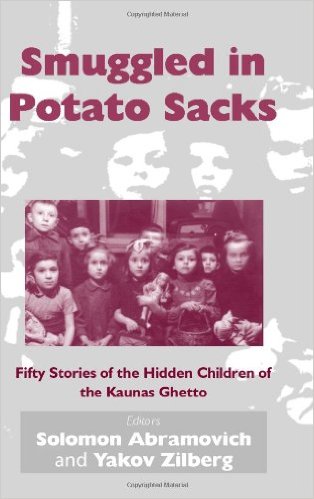
Smuggled in Potato Sacks
Sunday to Thursday: 09:00-17:00
Fridays and Holiday eves: 09:00-14:00
Yad Vashem is closed on Saturdays and all Jewish Holidays.
Entrance to the Holocaust History Museum is not permitted for children under the age of 10. Babies in strollers or carriers will not be permitted to enter.

Smuggled in Potato Sacks
Smuggled in Potato Sacks
Edited by Solomon Abramovich and Yakov Zilberg
Vallentine Mitchell, 2011
416 pages
Smuggled in Potato Sacks is a collection of stories compiled by Holocaust survivors Ariela Abramovich Sef and Ilana Kamber-Ash, both born in the Kovno Ghetto and hidden during the Holocaust. Inspired to preserve their own stories as well as those of other children who had been rescued, they collected as many testimonies as they could find, and in the end, put together this book with fifty stories of hidden children from the Kovno Ghetto.
On July 11, 1941, the Germans instructed the Lithuanian military commander and the mayor of Kovno to issue an order that by August 15th all the Jews in the city were to move into a ghetto in Slobodka. This was after thousands of Jews had already been brutally tortured and murdered. Some 29,000 Jews, including 5,000 children, were concentrated into the Kovno Ghetto, an area of small houses with no running water. Conditions in the ghetto were terrible and many Jews died of starvation and disease. There were frequent actions in which Jews were chosen for life or death, and murders occurred often.
Even with this devastating reality, parents tried to preserve some kind of childhood for their little ones. They celebrated birthdays and holidays as best they could. Schools had been organized but once educational instruction was banned in August 1942, some children were taught privately and some hid in their houses. By this point, hundreds of children had already been killed in pogroms or “actions” and 4,273 out of 5,000 were murdered in a single day during the “Great Action.” In November 1943, the underground organization increased its efforts to rescue children, aware of their almost certain fate. Through their arrangements, private contacts, and prewar neighbors, children were smuggled into Gentile homes with families who agreed to take the risk of rescuing Jewish children.
This book records fifty stories of such children, some who did not understand their new surroundings when they arrived, and some who never forgot their birth parents. Each story is told by the survivor and feels as if you are listening to him/her recount this part of his/her life. This is perfect for a classroom activity about hidden children or to discuss Righteous Among the Nations, since each story touches on these topics and is manageable for one or a group of students to read and understand. Teachers should read the stories in advance, to make sure they are not too violent and that they fit with the unit being taught.

Thank you for registering to receive information from Yad Vashem.
You will receive periodic updates regarding recent events, publications and new initiatives.

"The work of Yad Vashem is critical and necessary to remind the world of the consequences of hate"
Paul Daly
#GivingTuesday
Donate to Educate Against Hate


Worldwide antisemitism is on the rise.
At Yad Vashem, we strive to make the world a better place by combating antisemitism through teacher training, international lectures and workshops and online courses.
We need you to partner with us in this vital mission to #EducateAgainstHate
The good news:
The Yad Vashem website had recently undergone a major upgrade!
The less good news:
The page you are looking for has apparently been moved.
We are therefore redirecting you to what we hope will be a useful landing page.
For any questions/clarifications/problems, please contact: webmaster@yadvashem.org.il
Press the X button to continue



